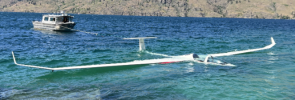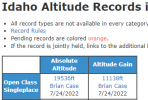UngaWunga thanks for posting the video.
This is my go to video that they showed me when I when through the altitude chamber.
The theme here is it is good to be cautious with hypoxia.
The common theme I see is that the brain get stuck in a loop... i.e.
...everything becomes a 4 of spades.
...all the shape are now squares
...Whatever you were doing you probably will just keep doing it, unable to make a decision.
Most racing glider pilots I know start using O2 at 5000'. Not necessarily because the need it, but because it is a cheap, legal, performance enhancing drug that gives them a slight edge (better decisions) than the pilot not using O2.
Below is likely the result of a O2 system that wasn't setup/working properly. The pilot never intended to leave the vicinity of the airport, was just going to be a high altitude (16,000ft) local flight. Once at altitude he flew out of range of the airport.
overflew another airport he was familiar with then flew out of range of that airport to a point where the only suitable landing area he could reach was the lake. He remembers the flight but had no explanation for how he could made such poor decisions, until about 2 month after the accident he was discussing the flight with another pilot and it came out that the pilot was unaware that the Cannula he was using (he had borrowed it from his power plane) was incompatible with the O2 system in the glider. A bit more research indicated that as a result he likely getting very little oxygen.

I had an O2 system fail on me once as well, it failed after the flow indicator (leaking) so I had no indication that it wasn't working. I flew at about 12,000-13,000 feet for about an hour, than got up 16,000 feet. At 16,000 feet I began to notice the tunnel vision and just not feeling very good. A bit of checking the O2 system I found the broken O2 line and was able to repair it but I was now an hour and 1/2 away from the airport. I turned around a flew back to the airport, landed and put the glider away and then took a long nap.
2 years ago while experimenting with an ATC clearance for a Glider and my new ADS-B system, I accidently set the state altitude record. I had no idea the record was that low and had previous been set in 1962.

Brian
CFIIG/ASEL



